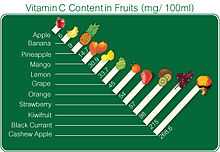Cashew apple juice

The cashew tree, Anacardium occidentale L., is called marañon in most Spanish-speaking countries, and caju or cajueiro in Portuguese. The true fruit of the tree is the cashew nut resembling a miniature boxing-glove. It consists of a double shell containing a caustic phenolic resin in honeycomb-like cells, enclosing the edible kidney-shaped kernel. The nut develops first and when it is full-grown its peduncle fills out, and becomes plump, fleshy, pear-shaped or rhomboid-to-ovate. It is 2 to 4 1/2 in (5-11.25 cm) in length, with waxy, yellow, red, or red-and-yellow skin and spongy, fibrous, very juicy, astringent, acid to subacid, yellow pulp. This is the so-called cashew apple.
Cashew apple juice (cashew fruit juice)
The Cashew Apples or Cashew Fruit which weigh about 5 to 10 times as much as the nuts.[1] In Goa, India, the apples are trampled to extract the juice for a distilled liquor, feni. Cashew apples also are preserved in syrup in glass jars, as they are highly perishable. Food technologists in India discovered that good condition can be kept for up to 5 weeks at 32°F to 35°F (0º-1.67°C) and a relative humidity of between 85% and 90%. The juice is astringent and somewhat acrid due to 35% tannin content (in the red, less in the yellow) and 3% of an oily substance, so it is pressure-steamed for 5 to 15 minutes before candying or making into jam or chutney or extracting the juice for carbonated beverages, syrup or wine. Efforts are made to retain the ascorbic acid. Food technologists in Costa Rica have found an improved process for producing the locally popular candied, sun-dried cashew apples. Failure to remove the tannin from the juice may account for the nutritional deficiency in heavy imbibers of cashew apple wine in Mozambique, for tannin prevents the body's full assimilation of protein.[2]

Scientific research on the cashew apple
1. The cashew is rich in Anacardic acid which helps stop the formation of breast cancer (BT-20 Breast Carcinomas).; (Itokawa et al.,1978—87; LLtokawa et al., 1989; Kubo et al., 1993 a,b)
2. The cashew contains "cadol", a substance which effectively blocks the growth of Hela Epithelioid Cervix Carcinoma Cells in the vagina. Moreover, it acts as an antiseptic and kills worms.
3. The phenol compounds in the cashew nut can slow down the release of "tyrosinase" enzyme which is involved in the formation of the dark pigment melanin causing freckles and blemishes.
4. The pulpy part of the cashew apple is used to produce the juice. In the form of juice, it can relieve scurvy due to its high level of vitamin C (up to 20,000 ppm or five times more than oranges), which is a substance capable of capturing free radicals.[3]
5. Since the cashew is rich in vitamin C and mineral salts, it is used as a coadjutant in the treatment of premature aging of the skin.
6. The main heat related degradation reaction of the β-cryptoxanthin pigment found in cashew apple fruit juice is isomerization of trans to cis-configuration. This is accompanied by formation/rearrangement of epoxides and furanoides, as well as cleavage to apocarotenal.[4]
7. According to a study published in the Journal of the International Society of Sports Nutrition entitled Cashew apple juice supplementation enhanced fat utilization during high-intensity exercise in trained and untrained men, “CAJ [cashew apple juice] enhances fat oxidation during exercise [and] may enhance endurance performance, but specific studies are needed to assess this possibility” (Prasertsri et. all).
References
- ↑ The Natural Food Hub, “Natural food – Fruit Vitamin C Content”, Eur Food Res Technol (2000), S.T. Lower and C.K. Agyente-Badu (2009)
- ↑ Morton, J. (1987)Cashew Apple. p. 239–240. In: Fruits of warm climates. Julia F. Morton, Miami, FL.
- ↑ The Natural Food Hub, “Natural food – Fruit Vitamin C Content”, Eur Food Res Technol (2000), S.T. Lower and C.K. Agyente-Badu (2009)
- ↑ Zepka, Leila Q.; Mercadante, Adriana Z. (2008), "Degradation products formed during carotenoid heating in a simulated cashew apple juice", 5th Pigments in Food congress- for quality and health (Print), University of Helsinki, ISBN 978-952-10-4846-3